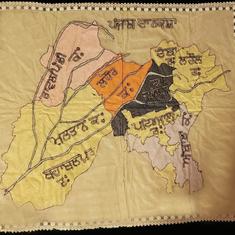On November 10, Preeti Mahesh Vani sat in an aanganwadi centre in Palghar with her three-and-a-half-year-old son Parth in her lap and relief on her face. Parth had been diagnosed with severe acute malnutrition, a life threatening condition that requires urgent treatment, and was now being cared for at the government-run aanganwadi. After 25 days into the month-long treatment, Parth’s case was classified as moderate acute malnutrition – still life-threatening but a shade better than severe acute malnutrition.
Severe acute malnutrition, which is commonly known by the abbreviation SAM, manifests itself in children as visible severe muscle wasting, lower height than usual for their age, and nutritional oedema – swelling due to insufficient protein intake. Children with SAM are at nine times the risk of death as well-nourished children. Malnutrition affects their physical growth, cognitive and motor development, and makes them susceptible to disease.
“At present, Parth is on medication and a special diet of six meals a day for 30 days,” said Vani, who is a resident of Siwali village in Mokhada taluk, one of the taluks in Maharashtra’s Palghar district with a high incidence of malnutrition. Vani works in the fields, while her husband is a subsistence farmer and rears goats.
“Parth was the only SAM category child in my aanganwadi,” said Anusya Ramesh Lakhar, who has been managing the aanganwadi centre, a government-sponsored child- and mother-care centre, in Siwali village for 30 years. Since September the aanganwadi has admitted eight children with are moderate malnourishment and under Lakhar’s care, five of these children have recovered enough to be classified as “normal”.
Lakhar vouches for the special diet and treatment under the Maharashtra government’s Village Child Development Centre or VCDC scheme, which has helped severely malnourished children like Parth. After almost a year of being defunct, the VCDC scheme was restarted at the end of October.
Palghar deaths
The VCDC scheme was launched in 2005 under a state-level mission to tackle malnutrition called the Rajmata Jijau Mother-Child Health and Nutrition Mission. Under the scheme, children suffering from acute malnutrition are enrolled in local aanganwadis and provided six nutritious meals a day for 30 days. Meals consist of khichadi, poha or beaten rice, eggs, and bananas. They are also given supplements of calcium, iron, and folic acid. This special diet daily provided 940 calories of food and 20 gm of protein to each acutely malnourished child.
Children who fail to respond to VCDC treatment may be admitted at the Child Treatment Centre and the Nutrition Treatment Centre at the district hospital for two to three weeks.
The VCDC project has been funded both by the Maharashtra state government and the central government under the National Rural Health Mission. In 2015, the National Rural Health Mission cut the entire budget for VCDC programme and the state got nothing of the Rs 6 crore that it had requested from the centre.
It took deaths of hundreds of malnourished children of Palghar to revive the VCDC project.
As per the official records, since April 1 this year, 254 children have died due to malnutrition in Palghar. The worst-affected regions are the Mokhada taluka, which 75 children died, and and Jawhar taluka, where 47 children died. Both are predominantly poor Adivasi areas.

Following these deaths, the state government decided to restart the VCDC programme across all 97,287 aanganwadis. This scheme has been running in some tribal pockets of the state for the last three months.
The mission, activists say, has not been carried out in sustained manner. Purnima Upadhyay of Khoj, an NGO that works with the tribal population in Melghat region of Maharashtra, said that unlike the mission’s first phase between 2005 and 2010, the present phase has no regular training of aanganwadi workers and no counseling of mothers. “Because of this, the relapse rate is as high as 40%-50%,” she said.
From the experience of Vani, Parth’s mother, this observation seems to be true. She had no idea what medicines were given to her son.
“During the 30 days of VCDC, the mother must be counseled and educated about the dietary needs of her child, so that she can continue feeding nutritious food to her child four to five times in a day,” said Abhay Bang, founder director the Society for Education, Action and Research in Community Health in Gadchiroli.
Years to get to “normal”
“I hope that by the time Parth finishes 30 days of VCDC, he comes out of moderate malnutrition and becomes a ‘normal’ child,” said Lakhar.
Even if Parth fails to do so, Lakhar will have to stop feeding him six meals a day because of official protocol. The programme allows for an aanganwadi caretaker to spend only Rs 1,200 per child per month, after which the child ceases to get any benefits from the programme.
Despite vouching for the efficacy of the VCDC diet, Lakhar expressed doubts that 30 days were enough to ensure that a child like Parth, who could easily slip back into SAM, was out of danger.
Some 15 kms away from Siwali village is Shirasgaon village where, more than three years ago, Ankush Bhagwan Vaijal was born underweight at just 1.5 kg. He also had a twin brother who weighed 2 kg at birth and died recently due to high fever. Ankush has four other siblings.
Through his infancy, Ankush kept hopping the line between severe acute malnourishment and moderate acute malnourishment. Only last April, when he turned two, he was declared normal, said Sunita Chandrakant Khade, the local aanganwadi caretaker.
It takes years for children like Ankush to become normal because there is no consistency in their care. His parents, like other poor people in the region, migrate to cities to find work for three to five months after Diwali. During this time, the migrants’ children fall off aanganwadi records and specialised care during these crucial initial months of their lives is suspended. For instance, there is no record of Ankush’s growth parameters between five months and nine months of age.
In December 2013, when Ankush’s parents returned from Mumbai where they had migrated for work for four months to Shirasgaon, the 10-month-old boy weighed only 6.2 kg and was categorised severely malnourished. It took 11 months of care at the aaganwadi to get Ankush out of SAM. When he was two, Ankush gained the normal weight for his age of 9.2 kg.
Children who are not as fortunate as Ankush and do not receover with care in the VCDC are referred to Patangshah Kutir Rugnalaya, a hospital at Jawhar about 25 kms away. But few children are actually taken to this hospital for further care.
“Women in Mokhada have four to five children, and cannot leave other children behind for 14-21 days,” said Lakhar, referring to the time it takes to treat a malnourished child at the hospital. “It also means a loss of their daily wages.”
Piecemeal approach won’t work
Despite these limitations, the state government is confident of positive results.
“In the last three months, we have already covered 85% children [6 months-6 years] of Palghar under VCDC,” said Abhijeet Bangar, collector of Palghar. “In case some children slip back, we will repeat the VCDC after six months.”
But public health and nutrition experts feel that the government should take a more holistic approach to tackle malnutrition.
“Six times a day nutritious meal for 30 days can help pull a child out of the SAM category,” said Veena Shatrugna, former deputy director of National Institute of Nutrition at Hyderabad. “However, there is no long-term plan to ensure that the child does not fall back to severe malnutrition.”
The community-based campaign Action Against Malnutrition under the Public Health Resource Network is demanding full continuum care of children, and not just care when a child becomes malnourished.
“Intervention should be made as soon as the child’s growth starts faltering,” said Vandana Prasad, paediatrician and national convenor of the network.
A child who has been treated at a VCDC centre for malnutrition should continue to eat healthy food four to five times a day, said Shatrugna. “The government must provide additional ration of high calories and high protein density in the form of extra oil, groundnuts, eggs, milk powder, etc through the public distribution system till the child reaches an age of five years,” she added.
The network is also demanding the immediate implementation of the 2013 National Food Security Act, which is supposed to support 75% of the rural population and 50% of the urban population under the targeted public distribution system. The Act also provides pregnant women and lactating mothers maternity benefits of not less than Rs 6,000.
“Unfortunately, it’s been three years and not a single mother has received maternity entitlement under the Act,” said Prasad.
The lessons from Palghar are evident. Tackling malnutrition and eliminating SAM will need a comprehensive long-term strategy that includes maternal and child care, nutrition counselling, supplementary nutrition, community participation and regular flow of funds. Fire-fighting with ad hoc schemes will not work.
The writer is an independent environment and development journalist in Mumbai.
This reporting project has been made possible partly by funding from New Venture Fund for Communications.









